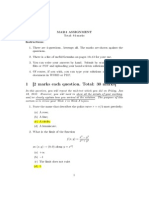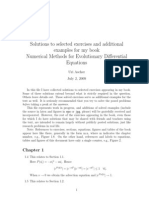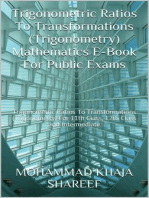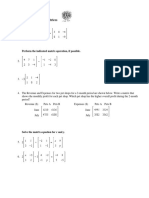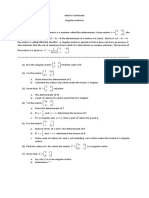Tutorial 4: Determinants and Linear Transformations
Tutorial 4: Determinants and Linear Transformations
Uploaded by
Justin Del CampoCopyright:
Available Formats
Tutorial 4: Determinants and Linear Transformations
Tutorial 4: Determinants and Linear Transformations
Uploaded by
Justin Del CampoOriginal Description:
Original Title
Copyright
Available Formats
Share this document
Did you find this document useful?
Is this content inappropriate?
Copyright:
Available Formats
Tutorial 4: Determinants and Linear Transformations
Tutorial 4: Determinants and Linear Transformations
Uploaded by
Justin Del CampoCopyright:
Available Formats
Mathematical Methods 1 2013
Tutorial 4: Determinants and linear transformations
Summary of what you have learnt The determinant of an n n matrix can be determined by expanding along any row or column. Moreover, EROs change the determinant in a controlled fashion. Linear transformations are functions from Rn to Rm preserving vector addition and scalar multiplication: (1) f (u + v ) = f (u) + f (v ) for all u, v in Rn ; (2) f (v ) = f (v ) for all v in Rn and all in R. They can be represented as matrices: columns represent the image of the basis vectors for Rn . You have also seen that composition corresponds to the product of matrices, and the inverse transformation corresponds to the inverse matrix.
Foundational questions 1 0 1 1 0 1 2 0 ? Exercise 1. What is the determinant of 0 0 2 1 0 0 0 5 Solution: Expanding Column 1, then Column 2, etc we see it is 1.(1).2.5 = 10. Exercise 2. Are the following functions linear transformations? (i) f1 : R2 (x, y ) R3 R2 (x, y ) R3 (ii) f2 : R2 R (x, y ) |x + y | R2
(iii) f3 :
(iv) f4 :
(x, y, z ) (y, x, z )
(x, y )
x2 y
if y = 0, if y = 0.
Solution: (i) Yes. f1 ((x, y ) + (x , y )) = f1 (x + x , y + y ) = (x + x , (y + y )) = (x, y ) + (x , y ) = f1 (x, y ) + f1 (x , y ) and f1 ((x, y )) = f1 (x, y ) = (x, y ) = (x, y ) = f1 (x, y ). (ii) No, it does not satisfy the second condition: f2 ((1)(1, 1)) = f2 (1, 1) = 2 while (1)f2 (1, 1) = (1)2 = 2. You can also show it does not satisfy the rst condition (but note that you only have to show one of them, not both): f2 ((1, 0) + (1, 0)) = f2 (0, 0) = 0 while f2 (1, 0) + f2 (1, 0) = 1 + 1 = 2. (iii) Yes. f3 ((x, y, z ) + (x , y , z )) = f1 (x + x , y + y , z + z ) = ((y + y ), x + x , z + z ) = (y, x, z ) + (y , x , z ) = f3 (x, y, z ) + f3 (x , y , z ) and f3 ((x, y, z )) = f3 (x, y, z ) = (y, x, z ) = (y, x, z ) = f3 (x, y, z ).
1
(iv) No. f4 does not preserve addition: f4 ((1, 1) + (0, 1)) = f4 (1, 2) = 1/2 while f4 (1, 1) + f4 (0, 1) = 1 + 0 = 1. Note that f4 does preserve scalar multiplication! Exercise 3. For each of the functions where you answered yes in the previous exercise, give the matrix with respect to the standard bases and a geometric description of the linear transformation. 1 0 Solution: The standard matrix for f1 is , it is a reection through the y -axis. 0 1 0 1 0 0 0 , it is a rotation of angle 90 degrees around the z -axis. The standard matrix for f3 is 1 0 0 1 Exercise 4. Let f5 : R2 R3 be the linear transformation mapping e1 to (1, 1, 2) and e2 to (0, 1, 1). What is the image of (1, 2) and of (x, y ) under f5 ? Solution: f5 (1, 2) = f5 (1, 0)+ f5 (0, 2) = f5 (1, 0)+2f5 (0, 1) = (1, 1, 2)+2(0, 1, 1) = (1, 3, 4). f5 (x, y ) = f5 (x, 0) + f5 (0, y ) = xf5 (1, 0) + yf5 (0, 1) = x(1, 1, 2) + y (0, 1, 1) = (x, x + y, 2x + y ). Conceptual understanding Exercise 5. For which value(s) of k is the following matrix invertible? [Hint: compute the determinant, starting with some row operations; do not rush into using the determinant formula.] 1 0 0 k 0 k 1 1 0 1 k k 1 0 0 2 Solution: The easiest method is to calculate the determinant, and see for which k it is non zero. Thus we need the answer to be factorised so that we can easily tell for which k it is equal to 0. 1 0 0 k 0 k 1 1 0 1 k k 1 0 0 2 = 0 1 k 2 1 k 2 1 k k 0 0 2k 1 0 0 k 2 0 0 1 k 1 k 2 0 1 k k 0 0 0 2k 0 1 k2 1 k R2 R2 kR3 R4 R4 R1
= (2 k )
= (2 k )(1 k 2 ) = (2 k )(1 k )(1 + k ).
So the matrix is always invertible except for k {1, 2, 1}. Exercise 6. Using the standard basis of R2 , determine the matrix of each of the following linear transformations, and compute their determinants: (1) a rotation of angle around the origin. (2) (Harder) a reection in a line forming an angle /2 with the x-axis.
2
Solution: cos() sin() (1) sin() cos() cos() sin() (2) sin() cos()
which has determinant cos()2 + sin()2 = 1. which has determinant cos()2 sin()2 = 1.
Exercise 7. Multiply the matrices found in the previous exercise to determine: (1) the composition of a rotation of angle 1 and a rotation of angle 2 , both around the origin. (2) the composition of a reection with itself. Hint: You may need the trig identities: cos(A + B ) = cos(A) cos(B ) sin(A) sin(B ) sin(A + B ) = sin(A) cos(B ) + cos(A) sin(B ) Solution: cos(1 ) sin(1 ) cos(2 ) sin(2 ) (1) sin(1 ) cos(1 ) sin(2 ) cos()2) cos(1 ) cos(2 ) sin(1 ) sin(2 ) cos(1 ) sin(2 ) sin(1 ) cos(2 ) = sin(1 ) cos(2 ) + cos(1 ) sin(2 ) sin(1 ) sin(2 ) + cos(1 ) cos(2 ) cos(1 + 2 ) sin(1 + 2 ) = . So the composition is a rotation of angle 1 + 2 . sin(1 + 2 ) cos(1 + 2 ) cos() sin() cos() sin() 1 0 (2) = . Composing a reection by itself sin() cos() sin() cos() 0 1 yields the identity. Exploration: Cross product
In R3 , the cross product of two vectors a = (a1 , a2 , a3 ) and b = (b1 , b2 , b3 ) is the vector (a2 b3 a3 b2 , a3 b1 a1 b3 , a1 b2 a2 b1 ). We denote it by a b. The trick to remember this formula is that the cross product is the determinant of the matrix e1 e2 e3 a1 a2 a3 . b1 b2 b3 Exercise 8. Let a = (1, 3, 1) and b = (2, 1, 5). Compute the following things. (i) (1, 3, 1) (2, 1, 5); (ii) (1, 3, 1) (1, 3, 1); (iii) the scalar product of a b with a and with b; (iv) the lengths of (1, 3, 1) (2, 1, 5), (1, 3, 1), and (2, 1, 5); (v) the angle between (1, 3, 1) and (2, 1, 5). (vi) Check that |a b| = |a||b| sin . Solution:
3
(i)
(ii) (iii) (iv) (v) (vi)
e1 e2 e3 1 3 1 = (16, 7, 5). (1, 3, 1) (2, 1, 5) = 2 1 5 e1 e2 e3 1 3 1 = (0, 0, 0). (1, 3, 1) (1, 3, 1) = 1 3 1 (1, 3, 1).(16, 7, 5) = 16 21 + 5 = 0 and 5) = 32 7 25 = 0. (2, 1, 5).(16, 7, 2 2 2 |(16, 7, 5)| = 16 + (7) + (5) = 330, |(1, 3, 1)| = 11, and |(2, 1, 5)| = sqrt30. To calculate an angle we use the scalar product: (1, 3, 1).(2, 1, 5) = 0, so = /2. In general a.b = |a||b| sin . sin = 1, so we just have |a b| = |a||b|, which is true.
Exercise 9. We now prove things in general, for any vectors a and b. (i) What is a a? (ii) Show that b a = a b. (iii) Show that a b is orthogonal (perpendicular) to a. (Similarly it is also orthogonal to b). (iv) Compute e1 (e1 e2 ) and (e1 e1 ) e2 . The cross product is not an associative operation, that is the position of the parenthesis is very important. (v) (hard) Show that |a b| = |a||b| sin , where [0, ] is the angle between the vectors a and b. Solution: e1 e2 e3 (i) a1 a2 a3 = (0, 0, 0) because the determinant has two lines equal. a1 a2 a3 (ii) It follows from the fact that when you switch two lines the determinant changes sign. (iii) We have to compute the scalar product (a2 b3 a3 b2 , a3 b1 a1 b3 , a1 b2 a2 b1 ).(a1 , a2 , a3 ) = a1 a2 b3 a1 a3 b2 + a2 a3 b1 a1 a2 b3 + a1 a3 b2 a2 a3 b1 = 0. (iv) e1 (e1 e2 ) = e1 e3 = e2 and (e1 e1 ) e2 = 0 e2 = 0. (v) The square of the left-hand side is: = (a2 b3 a3 b2 )2 + (a3 b1 a1 b3 )2 + (a1 b2 a2 b1 )2
2 2 2 2 2 2 2 2 2 2 2 = a2 2 b3 2a2 a3 b2 b3 + a3 b2 + a3 b1 2a1 a3 b1 b3 + a1 b3 + a1 b2 2a1 a2 b1 b2 + a2 b1
The square of the right-hand side is: = |a|2 |b|2 sin2 = |a|2 |b|2 (1 cos2 ) = |a|2 |b|2 |a|2 |b|2 cos2 = |a|2 |b|2 (a.b)2
2 2 2 2 2 2 = (a2 1 + a2 + a3 )(b1 + b2 + b3 ) (a1 b1 + a2 b2 + a3 b3 ) 2 2 2 2 2 2 2 2 2 2 2 2 2 2 2 2 2 = a2 1 b 1 + a1 b 2 + a1 b 3 + a2 b 1 + a2 b 2 + a2 b 3 + a3 b 1 + a3 b 2 + a3 b 3 2 2 2 2 2 a2 1 b1 a2 b2 a3 b3 2a1 a2 b1 b2 2a1 a3 b1 b3 2a2 a3 b2 b3 2 2 2 2 2 2 2 2 2 2 2 = a2 2 b3 2a2 a3 b2 b3 + a3 b2 + a3 b1 2a1 a3 b1 b3 + a1 b3 + a1 b2 2a1 a2 b1 b2 + a2 b1 .
So the squares of the RHS and LHS are equal, and since both sides are non-negative, they must be equal.
4
The cross-product ab is a vector which is perpendicular to both a and b, of length |a||b| sin , where [0, ] is the angle between the vectors a and b. There are two such vectors, so we need to be more precise. The direction of a b is determined by the following Right Hand Rule: suppose your right hand index nger is in the direction of a and your right hand middle nger is in the direction of b, then your right hand thumb indicates the direction of a b. [We are using the following orientation of the standard basis: your right hand thumb indicates the direction of e1 , your right hand index nger indicates the direction of e2 , and your right hand middle nger indicates the direction of e3 . This is the most common orientation used in engineering/physics.]
You might also like
- Linear Algebra Solution Manual by Peter OlverDocument350 pagesLinear Algebra Solution Manual by Peter OlverVirna Cristina Lazo78% (9)
- MAT1503 Exam SolutionsDocument93 pagesMAT1503 Exam Solutionsd_systemsuganda100% (1)
- HW 1Document3 pagesHW 1johanpenuela100% (1)
- Math 273 - Calc 3 HomeworkDocument11 pagesMath 273 - Calc 3 HomeworkTerry Aww Yiss ChernNo ratings yet
- Chapter 2. Vectors and Geometry 2.8. Solutions To Chapter ProblemsDocument74 pagesChapter 2. Vectors and Geometry 2.8. Solutions To Chapter ProblemsRob SharpNo ratings yet
- PS1 Solution 2Document16 pagesPS1 Solution 2Achilles TrojansNo ratings yet
- Analysis Qual ProblemsDocument40 pagesAnalysis Qual Problemsx420No ratings yet
- Advanced Calculus Test QuestionsDocument13 pagesAdvanced Calculus Test QuestionsRyan BaleNo ratings yet
- Exam1Review SolutionsDocument6 pagesExam1Review SolutionsParthav PatelNo ratings yet
- 2nd Sem Apr 2022Document12 pages2nd Sem Apr 2022rukkiya253No ratings yet
- Lesson 13 Transformation and Graphs of QFDocument5 pagesLesson 13 Transformation and Graphs of QFMarion Nico EspiloyNo ratings yet
- 30 QuestionDocument5 pages30 QuestionBeard CareNo ratings yet
- Answers On Task 7Document22 pagesAnswers On Task 7therealmarvin04No ratings yet
- Chapter 1 Calc Sinlge MultiDocument444 pagesChapter 1 Calc Sinlge Multiwhy2k6No ratings yet
- 5 - Question Bank - Advanced Engineering MAthematics-II - 21MTB41Document7 pages5 - Question Bank - Advanced Engineering MAthematics-II - 21MTB41G59 Satwik AIML-2021-25No ratings yet
- Module 4 - Dot and Cross Product PDFDocument15 pagesModule 4 - Dot and Cross Product PDFsubyNo ratings yet
- VectorDocument9 pagesVectorksuzukNo ratings yet
- Vector Calculus Solution ManualDocument29 pagesVector Calculus Solution Manualtjohnson93100% (7)
- Answers Ch2.3-2.5Document5 pagesAnswers Ch2.3-2.5ntokozocecilia81No ratings yet
- Exam1 SolsDocument18 pagesExam1 SolsLeandro RibeiroNo ratings yet
- 1.8.3 1008003 WvWAhKf0rDocument13 pages1.8.3 1008003 WvWAhKf0rkylinwu2No ratings yet
- Aieee Paper 2008Document30 pagesAieee Paper 2008Ravi LorventNo ratings yet
- WTW 124: Selected Answers To Chapter 1 (1.1 To 1.4) Exercise 1.1Document4 pagesWTW 124: Selected Answers To Chapter 1 (1.1 To 1.4) Exercise 1.1ntokozocecilia81No ratings yet
- Solutions To Exercises 1.1: 1. We HaveDocument29 pagesSolutions To Exercises 1.1: 1. We HaveTri Phương NguyễnNo ratings yet
- Question Bank (Paper MATDSCT 6.1)Document5 pagesQuestion Bank (Paper MATDSCT 6.1)khelgesantosh2002No ratings yet
- Signals and Systems Using MATLAB, Third Edition Solution ManuelDocument68 pagesSignals and Systems Using MATLAB, Third Edition Solution ManuelBunyamin UstaliNo ratings yet
- Final Practice SolDocument11 pagesFinal Practice SolChris MoodyNo ratings yet
- WTW 124: Selected Answers To Chapter 1 (1.1 To 1.4) Exercise 1.1Document4 pagesWTW 124: Selected Answers To Chapter 1 (1.1 To 1.4) Exercise 1.1ntokozocecilia81No ratings yet
- MAT1841 AppclassquestionsDocument27 pagesMAT1841 Appclassquestions邱顯鑫No ratings yet
- Namouzaj 1 PDFDocument6 pagesNamouzaj 1 PDFhaidarNo ratings yet
- Complex Analysis, Gamelin, II.7 Problems and SolutionsDocument5 pagesComplex Analysis, Gamelin, II.7 Problems and SolutionsC. Ephrem StuyvesantNo ratings yet
- DX X F I or A: Numerical Analysis Ch.3: Numerical IntegrationDocument16 pagesDX X F I or A: Numerical Analysis Ch.3: Numerical Integrationابراهيم حسين عليNo ratings yet
- Y Rango y Compruebe Con Geogebra: ( )Document16 pagesY Rango y Compruebe Con Geogebra: ( )Dego MorenoNo ratings yet
- Scott and Watson CHPT 4 SolutionsDocument4 pagesScott and Watson CHPT 4 SolutionsPitchou1990No ratings yet
- Calc 1 Prelim AnswersDocument10 pagesCalc 1 Prelim AnswersNeil MonteroNo ratings yet
- Elementary Maths Multiple Choice QuizDocument14 pagesElementary Maths Multiple Choice Quizjames daNo ratings yet
- EX2 PrepDocument11 pagesEX2 PrepmiguelitolinNo ratings yet
- WTW 124 Textbook Exercise Answers - 220817 - 085245Document70 pagesWTW 124 Textbook Exercise Answers - 220817 - 085245letsoaranliketsolitsoaneNo ratings yet
- New FinalExam reviewDocument12 pagesNew FinalExam reviewronglily134No ratings yet
- TJC JC 2 H2 Maths 2011 Mid Year Exam SolutionsDocument12 pagesTJC JC 2 H2 Maths 2011 Mid Year Exam SolutionsjimmytanlimlongNo ratings yet
- FHMW Student EditionDocument211 pagesFHMW Student EditionsammycatNo ratings yet
- MATH2117 Exam 2008s2 SolnDocument14 pagesMATH2117 Exam 2008s2 Solns3208510No ratings yet
- MATH 324 Coding and CryptographyDocument5 pagesMATH 324 Coding and Cryptographyrhch1309No ratings yet
- Math Sample Paper-1 (With Solutions)Document21 pagesMath Sample Paper-1 (With Solutions)Veeresh SavadiNo ratings yet
- Solutions Manual Corrections Linear Algebra OlverDocument7 pagesSolutions Manual Corrections Linear Algebra OlverZFise1959No ratings yet
- Unit 2 - Complex AnalysisDocument32 pagesUnit 2 - Complex AnalysisPavan BagalNo ratings yet
- Math 234, Practice Test #1Document4 pagesMath 234, Practice Test #1Adnan MehmoodNo ratings yet
- Concise Complex Analysis Solution ManualDocument53 pagesConcise Complex Analysis Solution Manual黃文菊100% (1)
- PT-2 QP 2021-22 Set-QDocument5 pagesPT-2 QP 2021-22 Set-QGunjan MeshramNo ratings yet
- MathsDocument23 pagesMathsamrt786111No ratings yet
- Solutions To Selected Exercises and Additional Examples For My Book Numerical Methods For Evolutionary Differential EquationsDocument19 pagesSolutions To Selected Exercises and Additional Examples For My Book Numerical Methods For Evolutionary Differential EquationskalantorNo ratings yet
- 12a Olym 2Document299 pages12a Olym 2micaelcarinhanhaNo ratings yet
- MATH320Document305 pagesMATH320Seyed SadeghNo ratings yet
- Solution 2005Document12 pagesSolution 2005BHAAJI0001No ratings yet
- Trigonometric Ratios to Transformations (Trigonometry) Mathematics E-Book For Public ExamsFrom EverandTrigonometric Ratios to Transformations (Trigonometry) Mathematics E-Book For Public ExamsRating: 5 out of 5 stars5/5 (1)
- Student Solutions Manual to Accompany Economic Dynamics in Discrete Time, second editionFrom EverandStudent Solutions Manual to Accompany Economic Dynamics in Discrete Time, second editionRating: 4.5 out of 5 stars4.5/5 (2)
- Student's Solutions Manual and Supplementary Materials for Econometric Analysis of Cross Section and Panel Data, second editionFrom EverandStudent's Solutions Manual and Supplementary Materials for Econometric Analysis of Cross Section and Panel Data, second editionNo ratings yet
- De Moiver's Theorem (Trigonometry) Mathematics Question BankFrom EverandDe Moiver's Theorem (Trigonometry) Mathematics Question BankNo ratings yet
- Transformation of Axes (Geometry) Mathematics Question BankFrom EverandTransformation of Axes (Geometry) Mathematics Question BankRating: 3 out of 5 stars3/5 (1)
- 2019 G09 Mathematics EM 0Document308 pages2019 G09 Mathematics EM 0Samama FahimNo ratings yet
- Econometrics 2Document84 pagesEconometrics 2josephnyamai1998No ratings yet
- Qcd, Wick'S Theorem For Kdv Τ -Functions And The String EquationDocument6 pagesQcd, Wick'S Theorem For Kdv Τ -Functions And The String Equationhelmantico1970No ratings yet
- MTH231 - LinearAlgebra by Dr. Muhammad ZubairDocument4 pagesMTH231 - LinearAlgebra by Dr. Muhammad Zubairmuhammad ahsanNo ratings yet
- 03 Matrices CDocument3 pages03 Matrices CRohitDalalNo ratings yet
- N n-1 n-2 n-3 n-4: Dr. D. Saravanan, Professor of MathematicsDocument13 pagesN n-1 n-2 n-3 n-4: Dr. D. Saravanan, Professor of MathematicsSivabalanNo ratings yet
- Practice Test On MatricesDocument10 pagesPractice Test On MatricesowaisNo ratings yet
- Singular Matrices and Transformation MatricesDocument1 pageSingular Matrices and Transformation MatricesShort BossNo ratings yet
- QuaternionDocument40 pagesQuaternionaldrin_mathNo ratings yet
- Ae5310midterm 2022 OctoberDocument6 pagesAe5310midterm 2022 OctoberJohnNo ratings yet
- Sequencing Problems - Operation Research CalculatorDocument2 pagesSequencing Problems - Operation Research Calculatormks5071No ratings yet
- Matrices and DeterminanatsDocument8 pagesMatrices and Determinanatsmadhav bhallaNo ratings yet
- MTE 3110 Linear AlgebraDocument3 pagesMTE 3110 Linear AlgebraIsmi Asma' IsmailNo ratings yet
- Algebra 7 Principles and Sample ProblemsDocument14 pagesAlgebra 7 Principles and Sample ProblemsKrisha Jean MacalinoNo ratings yet
- Course Outline MAT 125.6 Spring 2022Document5 pagesCourse Outline MAT 125.6 Spring 2022ABU MASROOR AHMEDNo ratings yet
- Ma110 Course Outline 1 1Document4 pagesMa110 Course Outline 1 1HarrisonNo ratings yet
- DL Unit1 FinalDocument41 pagesDL Unit1 FinalVvn BhaskarNo ratings yet
- Equations and Matrices - Summary NotesDocument4 pagesEquations and Matrices - Summary NotesVaishnavi VyapariNo ratings yet
- JEE Main Syllabus at A Glance Pages PDFDocument10 pagesJEE Main Syllabus at A Glance Pages PDFSuman DewasiNo ratings yet
- MA1513 Tutorial 2 T03Document108 pagesMA1513 Tutorial 2 T03MelodyNo ratings yet
- CE Board Problems in AlgebraDocument7 pagesCE Board Problems in AlgebraHomer Batalao100% (1)
- MATE1B1Document17 pagesMATE1B1katlegomofokeng870No ratings yet
- Mat150 E6 Practice PDFDocument2 pagesMat150 E6 Practice PDFsamygamalNo ratings yet
- Arihant Mathematics Engineering Solved Papers - WatermarkDocument1,136 pagesArihant Mathematics Engineering Solved Papers - Watermarkchocolateboy 22100% (4)
- Fortran Folheto V6Document83 pagesFortran Folheto V6Maurício Prado Martins0% (1)
- Matrices Cheat SheetDocument1 pageMatrices Cheat Sheetnimmiz999No ratings yet
- The Poincar e Group Sept. 23, 2013: 2005 by Joel A. ShapiroDocument10 pagesThe Poincar e Group Sept. 23, 2013: 2005 by Joel A. ShapiroGerman ChiappeNo ratings yet
- SMR 13 Math 201 SyllabusDocument2 pagesSMR 13 Math 201 SyllabusFurkan ErisNo ratings yet
- Cbse 12th Class Maths SyllabusDocument7 pagesCbse 12th Class Maths Syllabusaldrin9bNo ratings yet
- Srmjeee SyllabusDocument9 pagesSrmjeee SyllabusMd AshfaqNo ratings yet







